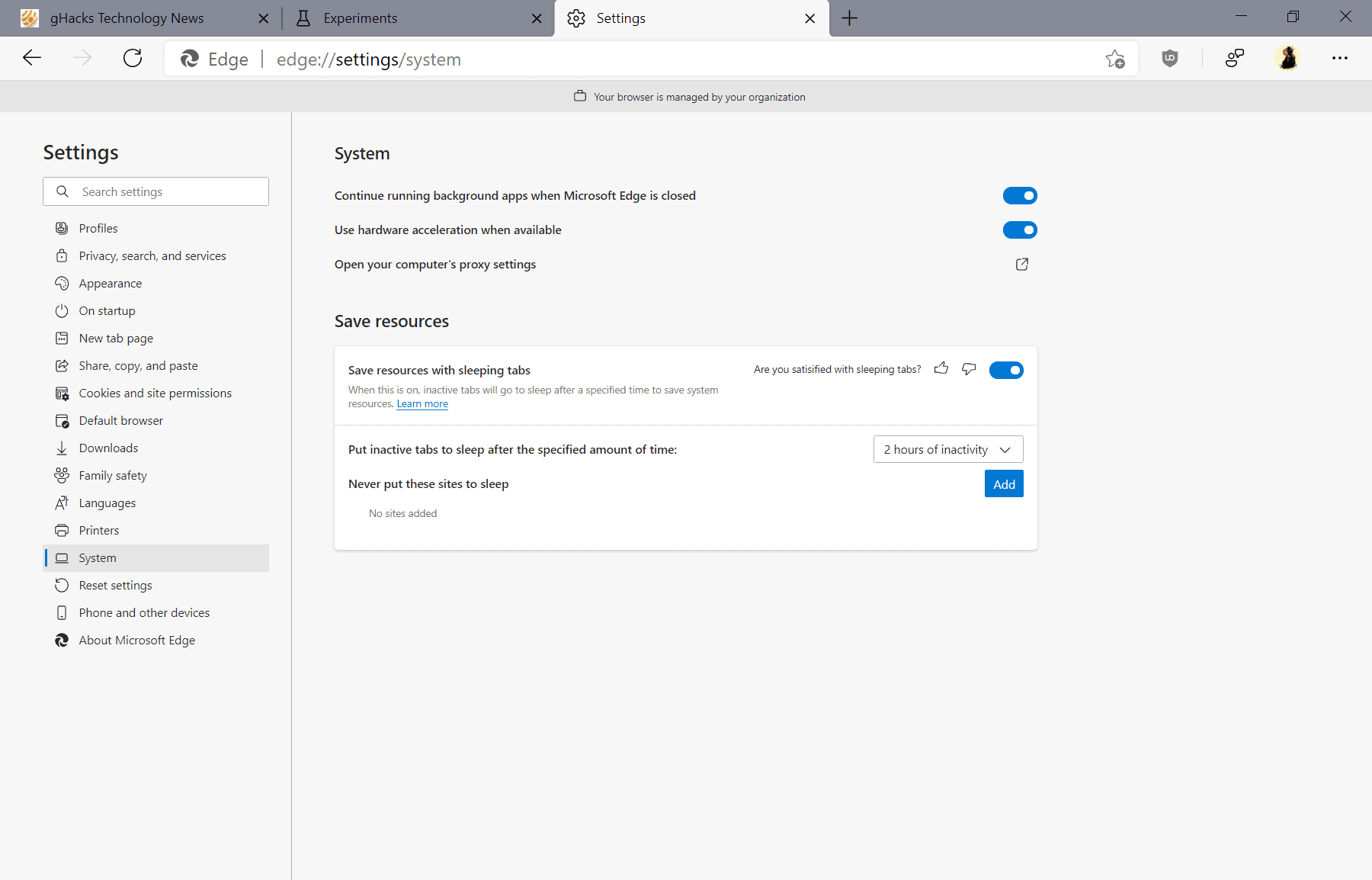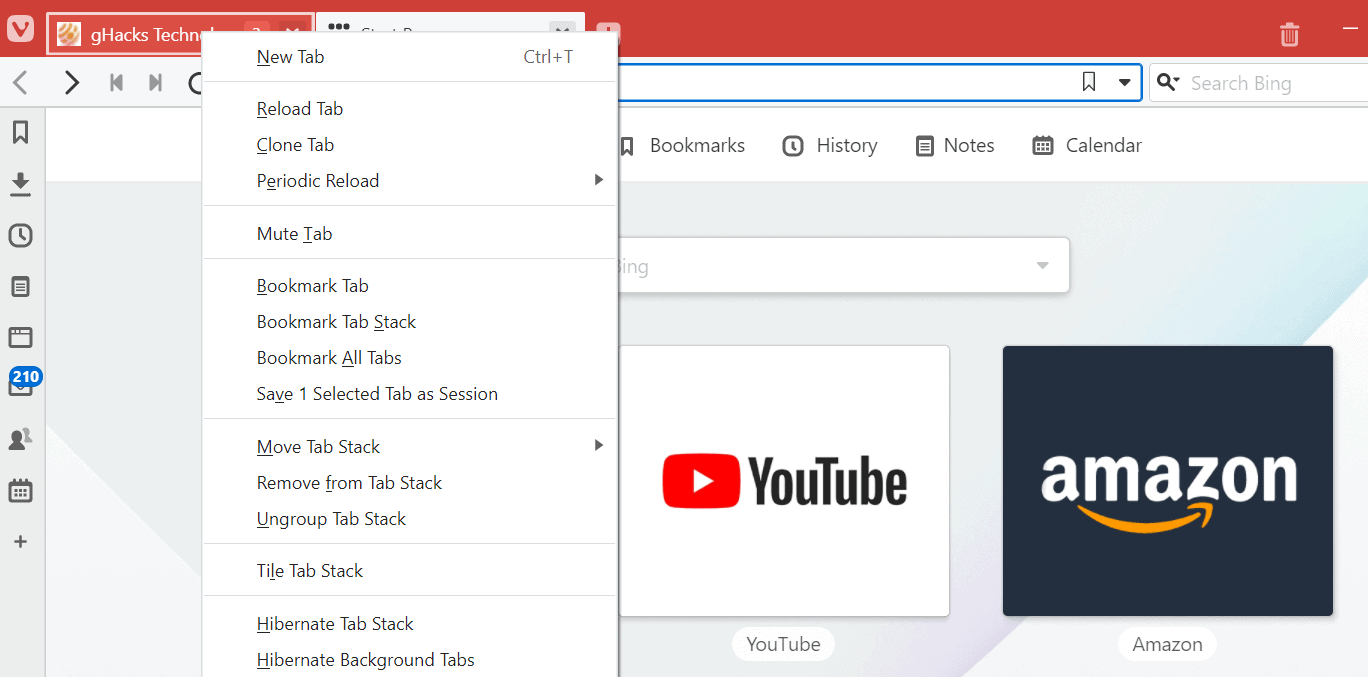Tab snoozing, also known as tab sleeping or freezing, is not a new feature, but it is getting added to more and more web browsers natively. The feature is designed to save resources, memory in particular, by unloading tabs and putting them to sleep. Unlike closing tabs, which removes the information from the tab bar, sleeping usually keeps the tab open in the tab bar but in an unloaded state. A click reloads the content so that the site’s content becomes accessible again.
Since tab snoozing is coming to more and more browsers, it may be interesting to see which have the best implementation at the time. Best needs to be defined, and in this case, we are focusing on usability. How much control do users have over the feature?
Which browsers do support tab snoozing natively?
- Google Chrome supports Tab Freezing.
- Microsoft Edge supports Tab Sleeping.
- Opera supports Tab Snoozing.
- Firefox supports automatic tab unloading.
- Vivaldi supports Tab Hibernating.
- Brave does not support it natively.
Notes:Â
- Most Chromium-based web browsers support the experimental feature Tab Groups, and with that feature comes another experiment that supports Tab Groups Collapse Freezing which improves resource usage.
- Mozilla ran a Snooze Tabs experiment in 2017 but did not integrate the functionality natively in Firefox. Snooze Tabs is available as a separate extension (not by Mozilla, it appears) though.
The implementation of the feature in browsers that support it
Google Chrome and Firefox
Google introduced Tab Freeze as an experiment in the company’s Chrome browser in 2019. It was not the company’s first try, as it introduced and removed a tab discard feature back in 2015 in the browser. Google removed the experiment, and it appears that tab freezing has been integrated in Chrome natively.
Tab Freezing is an automated feature that will unload tabs to free memory after five minutes of inactivity. Specifics, especially how the functionality is triggered, are unclear, other than that Chrome won’t freeze tabs that play media. The feature offers no user controls and the freezing happens automatically in the background after 5 minutes of inactivity.
Firefox supports an automatic tab discarding feature that works similarly to Google’s. It is not enabled by default, however, and needs to be enabled on about:config by changing the state of the preference browser.tabs.unloadOnLowMemory to TRUE.
Microsoft Edge (new)
Microsoft added the Sleeping Tabs feature to Microsoft Edge 87 in September 2020. The feature, experimental at the time, to give users options to free up resources by unloading background tabs.

Tab Sleeping needs to be enabled before the feature becomes available, and it supports an additional option to put background tabs into sleep mode immediately.
The browser paints tabs that are sleeping in a lighter gray text color to provide users with a visual indicator. Hovering over a tab displays a confirmation as well that a tab is sleeping.
Edge puts tabs to sleep after 2 hours of inactivity by default. You can change the time period and add sites to an exclusions list to prevent them from ever being put to sleep. ×
×
Just load edge://settings/system in the address bar to access the configuration options under “Save resources”. Note that you only see the options if you enabled the main Tab Sleeping experiment on edge://flags.
Opera

Opera Software introduced tab snoozing in Opera 74 (stable is at version 73 at the time of writing), spotted by Techdows. The feature is enabled by default, at least in the development builds it is available in. It is called Snooze inactive tabs to save memory and you can toggle it by loading opera://settings/vpn in the browser’s address bar, scrolling down to the user interface group on the page, and clicking on the feature listed there. The current implementation offers no settings or controls.
Vivaldi

The Vivaldi web browser supports tab hibernating; users can hibernate individual background tabs or tab stacks. All it takes is to right-click on a tab or tab stack that is not active, and select the hibernation options.
Tabs and tab stacks remain on the tab bar but the content is unloaded. A click on a tab reloads its content on demand.
Closing Words
Microsoft’s Edge browser is the clear winner when it comes to tab freezing / sleeping functionality. It is the only browser that supports setting different intervals before the feature kicks in and a list of exclusions.
Vivaldi supports a manual option which gives users full control over the feature, but is less convenient than an automated option.
A list of exclusions is essential, as tab unloading may interfere with certain sites or web applications.
